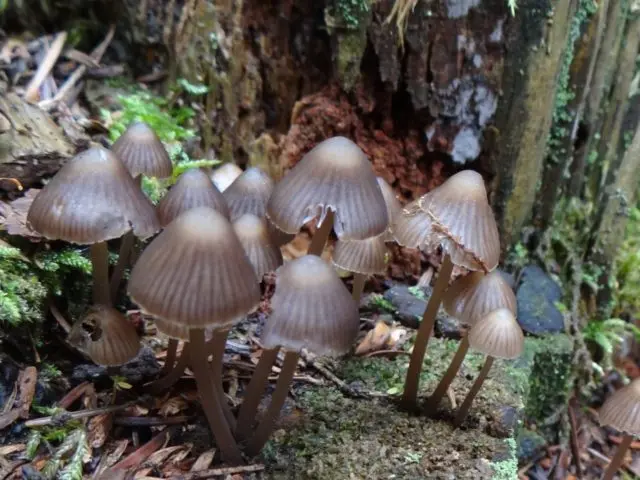Contents
Mycena alkaline, caustic, cone-loving or gray – these are the names of the same mushroom. In mycological reference books, it is also designated under the Latin name Mycena alcalina, it belongs to the Mycena family.

Fruits grow in compact groups covering large areas
What do alkaline mycenae look like?
The species forms small fruiting bodies, consisting of a stem and a cap. The shape of the upper part changes during the growing season, the base of the lower half is hidden in the substrate.
The external characteristic of alkaline mycena is as follows:
- At the beginning of growth, the cap is semicircular with a conical bulge in the center, with time it straightens and becomes completely prostrate with clear, slightly wavy edges, protruding plates create unevenness.
- The minimum diameter is 1 cm, the maximum diameter is 3 cm.
- The surface is velvety smooth without a mucous coating, with radial longitudinal stripes.
- The color of young specimens is brown with a creamy tint, brightens during the growing season and becomes fawn in adult mushrooms.
- The center always differs in color, it can be lighter than the main tone or darker depending on the lighting and humidity.
- The lower part is lamellar. The plates are thin, but wide, with a clear border near the stem, and are rarely located. Light with a gray tint, do not change color until the fruiting body ages.
- The flesh is fragile, thin, breaks on touch, beige.
- Microscopic spores are transparent.
- The stalk is high and thin, of the same width along the entire length, often most of it is hidden in the substrate. If it is completely on the surface, then thin white filaments of mycelium are clearly visible near the mycelium.
- The structure is fragile, hollow inside, fibrous.
The color is the same as the upper part or a tone darker, yellowish fragments are possible at the base.

Mycena of the correct proportional shape, hat-and-leg type
Where do alkaline mycenae grow?
It is difficult to call a widespread fungus, it forms numerous colonies, but is rare. It is listed in the Red Book of the Moscow Region as a rare species. The small area is associated with the way mycena grows, it enters into symbiosis with conifers. The peculiarity is that it grows only on fallen spruce cones.
If the mushrooms are covered with rotten perennial coniferous litter or hidden under decaying deadwood, then the lower part of the fruiting body develops in the substrate. Only caps protrude to the surface, the mushroom looks squat. A false impression is created that the mycelium is located on rotting wood. It grows in all regions and types of forests where spruce predominates. Fruiting is long, the beginning of the growing season is immediately after the snow melts and before the onset of frost.
Is it possible to eat alkaline mycenae
The chemical composition of the alkaline mycena is poorly understood; the species with a small fruiting body and fragile thin pulp is of no nutritional value. The pungent chemical smell does not add popularity either.
Conclusion
Mycena alkaline is common in coniferous and mixed massifs, creates a symbiosis with spruce, or rather grows on fallen cones. Forms dense colonies from early spring until frost. A small mushroom with an unpleasant smell of alkali has no nutritional value, it is classified as an inedible species.









